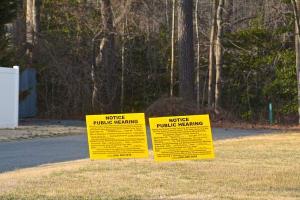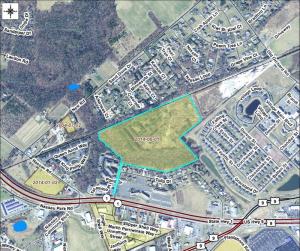Reserves at Nassau now for seniors
It came as no surprise that area residents opposed to a proposed housing project off Route 1 behind Dutch Acres expressed concerns about access to the 147-mixed-unit project.
The road leading to the proposed Reserves at Nassau, Phase 2, is Tulip Drive, the same street parishioners of St. Jude the Apostle Catholic Church and residents of Dutch Acres and Villas of Taramino use to access Route 1.
It now appears the developer, Ocean Atlantic Communities LLC, has no other choice. The parcel is surrounded on three sides by other developments and another side by the Penn Central railroad track.
A similar project proposed on the same 37-acre parcel was never built. It was approved by county council in 2005 with an entrance off Old Orchard Road shared with Atlantic Concrete, even though most agreed the proposed entrance was not safe.
“We are all concerned about safety,” said Mike Pfarr, business manager at St. Jude the Apostle Catholic Church, adjacent to the proposed development.
He stressed how busy the schedule is at the church, which occupies 14 acres. He said traffic issues are not reserved to Sunday because the church has several other services and programs throughout the week. He said residents in the area around the church use the church parking lot as a shortcut, and he said that would only get worse with more development in the area.
“We are not opposed to the development, but we don't like Tulip Drive as the access,” he said.
That same statement was repeated by several other residents opposed to the applications during more than three hours of testimony at a March 26 Sussex County Planning and Zoning Commission public hearing.
Proposal changed to 55-plus community
Ocean Atlantic Communities has filed two applications with Sussex County. Developers are seeking a rezoning from AR-1, agricultural-residential, to MR, medium-density residential, for the parcel and also requesting a conditional use for mixed-use, multifamily housing.
Jim Fuqua, attorney for the developer, said following the state review of the project, the developer changed the concept of the project to a 55-plus community, which generally have less impact on traffic than other types of communities. The proposed layout includes 43 single-family houses, 46 duplex units and 58 townhouses built in condominium style. No sidewalks are proposed.
Proposed amenities include a pool, clubhouse, playground and trailhead for the proposed Georgetown to Lewes rail-trail, which would run along the northern border of the community. The developer would grant a 5-foot easement to add to the existing right-of-way for the proposed trail. A parking lot would also be provided.
“It's in a growth area surrounded by a higher, intense-use growth area. It's a textbook example of in-fill zoning. This is the doughnut hole surrounded by the MR and C-1 doughnut,” Fuqua said.
A section of the parcel was once a borrow pit that has been filled in with tree stumps and construction debris. As part of the state's brownfield program, the developer has been required to submit a 1,400-page remediation plan, which will be supervised by Department of Natural Resources and Environmental Control staff.
When questioned about the plan, developer Preston Schell said the environmental analysis took six months and cost $150,000.
Under the proposed plan, material will be removed from the site and a section of oil-contaminated soil will be sealed with the construction of a parking lot for the rail-to-trail access.
“There are no hazardous or safety concerns,” said Zac Crouch of Davis, Bowen and Friedel, an engineer for the attorney.
A study showed the traffic expected to be generated by the proposed project was not enough to change the operation of the traffic signal at the intersection of Route 1 and Tulip Drive. The signal is on yellow flash and is manually operated by a Delaware State Police trooper on Sundays when church services get out. “The light will continue to operate the way it does now,” Fuqua said.
Fuqua said the reformulated plan for the parcel is better than the 152-unit project approved by council in 2005. He said the dangerous entrance has been relocated, the number of units has been reduced and the age-restricted concept for the community provides less impact than a standard development.
D.J. Hughes, the developer's traffic engineer, said traffic generated by a 55-plus community is about half that generated by a standard single-family community. He said the community would generate about 666 average trips per day – 333 in and 333 out.
Schell said several disclosures would be made to buyers in the community: information that a rail-to-trail project was likely to occur; a photograph of the sign posted in front of Atlantic Concrete noting that dust and noise is generated by the plant; and that a 5-acre parcel adjacent to the plant will eventually be converted to a cement reclamation area.
Schell said because of concerns expressed by Villages of Five Points residents, a proposed connector path to the rail-to-trail parking area would be eliminated from the proposed site plan and a 20-foot vegetated buffer would be planted along the boundary of the two communities.
The community would be served with central sewer by Sussex County and central water by Tidewater Utilities.
Residents raise concerns with application
Under the proposed plan, the extension of Tulip Drive into the community would include a bridge over wetlands, which would require a federal permit.
Area residents also expressed environmental concerns. Kenneth Ciarlone, who lives on Taramino Place, questioned the potential impact on tidal wetlands on the parcel. He said the proposed buffers were not adequate.
Crouch said a minimum of 20-foot buffers would be maintained around wetlands on the parcel. In addition, he said, removal of mature trees on the site would be kept to a minimum.
Some residents questioned plans for stormwater runoff. Crouch, the applicant's engineer, said there would be significantly less runoff from the parcel because of the proposed bioretention stormwater management areas that would be required.
Andy Martin, a Taramino resident, said he didn't see how the fundamental issues from the 2005 project had changed. “It's a bad spot,” he said. “This project is a multiplier of danger. I'm not saying this lightly. Unless there is a change in the access, I don't see how this could work.”


















































